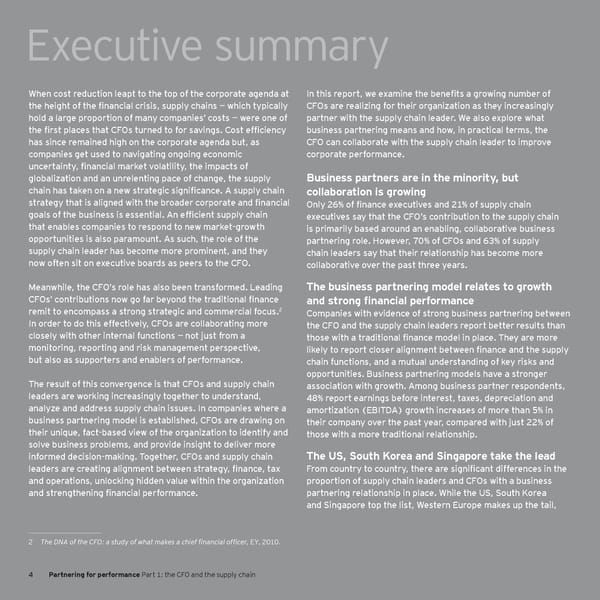Executive summary When cost reduction leapt to the top of the corporate agenda at In this report, we examine the benefits a growing number of the height of the financial crisis, supply chains — which typically CFOs are realizing for their organization as they increasingly hold a large proportion of many companies’ costs — were one of partner with the supply chain leader. We also explore what the first places that CFOs turned to for savings. Cost efficiency business partnering means and how, in practical terms, the has since remained high on the corporate agenda but, as CFO can collaborate with the supply chain leader to improve companies get used to navigating ongoing economic corporate performance. uncertainty, financial market volatility, the impacts of globalization and an unrelenting pace of change, the supply Business partners are in the minority, but chain has taken on a new strategic significance. A supply chain collaboration is growing strategy that is aligned with the broader corporate and financial Only 26% of finance executives and 21% of supply chain goals of the business is essential. An efficient supply chain executives say that the CFO’s contribution to the supply chain that enables companies to respond to new market-growth is primarily based around an enabling, collaborative business opportunities is also paramount. As such, the role of the partnering role. However, 70% of CFOs and 63% of supply supply chain leader has become more prominent, and they chain leaders say that their relationship has become more now often sit on executive boards as peers to the CFO. collaborative over the past three years. Meanwhile, the CFO’s role has also been transformed. Leading The business partnering model relates to growth CFOs’ contributions now go far beyond the traditional finance and strong financial performance remit to encompass a strong strategic and commercial focus.2 Companies with evidence of strong business partnering between In order to do this effectively, CFOs are collaborating more the CFO and the supply chain leaders report better results than closely with other internal functions — not just from a those with a traditional finance model in place. They are more monitoring, reporting and risk management perspective, likely to report closer alignment between finance and the supply but also as supporters and enablers of performance. chain functions, and a mutual understanding of key risks and opportunities. Business partnering models have a stronger The result of this convergence is that CFOs and supply chain association with growth. Among business partner respondents, leaders are working increasingly together to understand, 48% report earnings before interest, taxes, depreciation and analyze and address supply chain issues. In companies where a amortization (EBITDA) growth increases of more than 5% in business partnering model is established, CFOs are drawing on their company over the past year, compared with just 22% of their unique, fact-based view of the organization to identify and those with a more traditional relationship. solve business problems, and provide insight to deliver more informed decision-making. Together, CFOs and supply chain The US, South Korea and Singapore take the lead leaders are creating alignment between strategy, finance, tax From country to country, there are significant differences in the and operations, unlocking hidden value within the organization proportion of supply chain leaders and CFOs with a business and strengthening financial performance. partnering relationship in place. While the US, South Korea and Singapore top the list, Western Europe makes up the tail, 2 The DNA of the CFO: a study of what makes a chief financial officer, EY, 2010. 4 Partnering for performance Part 1: the CFO and the supply chain
 Partnering for Performance Part 1 Page 5 Page 7
Partnering for Performance Part 1 Page 5 Page 7